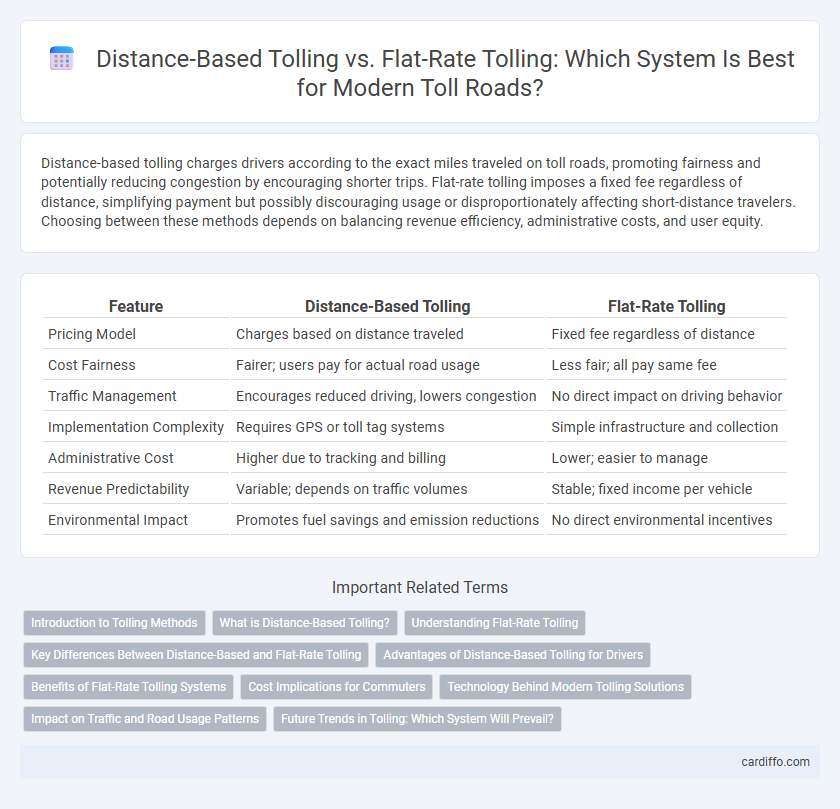Distance-based tolling charges drivers according to the exact miles traveled on toll roads, promoting fairness and potentially reducing congestion by encouraging shorter trips. Flat-rate tolling imposes a fixed fee regardless of distance, simplifying payment but possibly discouraging usage or disproportionately affecting short-distance travelers. Choosing between these methods depends on balancing revenue efficiency, administrative costs, and user equity.
Table of Comparison
| Feature | Distance-Based Tolling | Flat-Rate Tolling |
|---|---|---|
| Pricing Model | Charges based on distance traveled | Fixed fee regardless of distance |
| Cost Fairness | Fairer; users pay for actual road usage | Less fair; all pay same fee |
| Traffic Management | Encourages reduced driving, lowers congestion | No direct impact on driving behavior |
| Implementation Complexity | Requires GPS or toll tag systems | Simple infrastructure and collection |
| Administrative Cost | Higher due to tracking and billing | Lower; easier to manage |
| Revenue Predictability | Variable; depends on traffic volumes | Stable; fixed income per vehicle |
| Environmental Impact | Promotes fuel savings and emission reductions | No direct environmental incentives |
Introduction to Tolling Methods
Distance-based tolling charges drivers based on the exact miles traveled on toll roads, offering a fair and usage-sensitive payment system. Flat-rate tolling requires a fixed fee regardless of distance, simplifying payment but potentially leading to inefficiencies for short or long trips. Implementing distance-based tolling enhances traffic management and revenue allocation by promoting equitable road usage and reducing congestion.
What is Distance-Based Tolling?
Distance-based tolling charges drivers based on the exact miles traveled on tolled roads, promoting fairness by correlating payment directly with road usage. This method reduces congestion by incentivizing shorter trips and encourages efficient route choices compared to flat-rate tolling, which imposes a fixed fee regardless of distance. Advanced GPS and electronic toll collection technologies facilitate accurate distance measurement and seamless billing for drivers.
Understanding Flat-Rate Tolling
Flat-rate tolling charges drivers a fixed fee regardless of the distance traveled, simplifying payment and reducing administrative costs compared to distance-based tolling systems. This method is often preferred in urban areas or on short toll roads where travel distances are relatively uniform. While it may be less equitable for varying trip lengths, flat-rate tolling ensures straightforward revenue collection and predictable expenses for motorists.
Key Differences Between Distance-Based and Flat-Rate Tolling
Distance-based tolling charges drivers based on the exact distance traveled on a tolled road, promoting fairness and potentially reducing congestion by incentivizing shorter trips. Flat-rate tolling imposes a fixed fee regardless of distance, simplifying payment but potentially leading to inefficiencies and higher costs for short-distance travelers. Key differences include cost transparency, driver behavior influence, and administrative complexity, with distance-based systems requiring advanced tracking technology while flat-rate tolls rely on straightforward collection methods.
Advantages of Distance-Based Tolling for Drivers
Distance-based tolling offers drivers precise payment aligned with actual road usage, ensuring fairer charges and potentially reducing costs for short trips. This system encourages efficient route planning and can decrease congestion by promoting off-peak travel. Enhanced transparency in tolling data allows drivers to anticipate expenses accurately and optimize their travel choices.
Benefits of Flat-Rate Tolling Systems
Flat-rate tolling systems provide predictable costs for drivers, enhancing budget planning and reducing tolling complexity. These systems simplify administrative processes by eliminating the need for distance measurement infrastructure, lowering operational expenses significantly. Consistent toll fees encourage equity among users and streamline traffic flow by minimizing toll plaza congestion.
Cost Implications for Commuters
Distance-based tolling charges drivers based on the exact miles traveled, often resulting in fairer costs for commuters who travel varying distances. Flat-rate tolling imposes a fixed fee regardless of distance, which can lead to higher expenses for short-distance travelers and potential overpayment for those with shorter commutes. Commuters benefit from distance-based tolling by paying proportionally to their use, potentially reducing overall transportation costs compared to flat-rate systems.
Technology Behind Modern Tolling Solutions
Distance-based tolling leverages GPS and wireless communication technologies to accurately track vehicle mileage on tolled roads, enabling precise fare calculation based on distance traveled. Flat-rate tolling relies on traditional RFID or transponder systems that charge a fixed fee at toll plazas regardless of trip length. Modern tolling solutions integrate cloud-based data processing and real-time analytics to enhance toll collection efficiency, reduce congestion, and improve revenue management.
Impact on Traffic and Road Usage Patterns
Distance-based tolling incentivizes drivers to travel shorter distances and avoid congested routes, leading to more efficient road usage and reduced traffic congestion over time. Flat-rate tolling often results in uniform charges regardless of distance, which can discourage optimal route selection and may contribute to increased traffic on toll roads. Studies indicate distance-based systems improve traffic flow and promote equitable road usage by aligning costs with actual road consumption.
Future Trends in Tolling: Which System Will Prevail?
Distance-based tolling leverages GPS and sensor technology to calculate charges based on miles traveled, promoting fairness and reducing congestion by encouraging route optimization. Flat-rate tolling remains favored for its simplicity and predictability, especially in urban environments with high traffic volumes. Advances in smart infrastructure and real-time data analytics suggest distance-based tolling will increasingly dominate, driven by environmental goals and efficient traffic management.
Distance-based tolling vs flat-rate tolling Infographic

 cardiffo.com
cardiffo.com